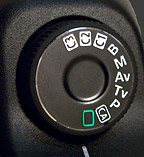CAMERA EXPOSURE MODES

Each of these modes influences how aperture, ISO and shutter speed are chosen for a given exposure. Some modes attempt to pick all three values for you, whereas others let you specify one setting and the camera picks the other two (if possible). The following table describes how each mode pertains to exposure:
| Exposure Mode | How It Works |
|---|---|
| Auto ( | Camera automatically selects all exposure settings. |
| Program (P) | Camera automatically selects aperture & shutter speed; you can choose a corresponding ISO speed & exposure compensation. With some cameras, P can also act as a hybrid of the Av & Tv modes. |
| Aperture Priority (Av or A) | You specify the aperture & ISO; the camera's metering determines the corresponding shutter speed. |
| Shutter Priority (Tv or S) | You specify the shutter speed & ISO; the camera's metering determines the corresponding aperture. |
| Manual (M) | You specify the aperture, ISO and shutter speed — regardless of whether these values lead to a correct exposure. |
| Bulb (B) | Useful for exposures longer than 30 seconds. You specify the aperture and ISO; the shutter speed is determined by a remote release switch, or by the duration until you press the shutter button a second time. |
| Exposure Mode | How It Works |
|---|---|
| Portrait | Camera tries to pick the lowest f-stop value possible for a given exposure. This ensures the shallowest possible depth of field. |
| Landscape | Camera tries to pick a high f-stop to ensure a large depth of field. Compact cameras also often set their focus distance to distant objects or infinity. |
| Sports/Action | Camera tries to achieve as fast a shutter speed as possible for a given exposure — ideally 1/250 seconds or faster. In addition to using a low f-stop, the fast shutter speed is usually achieved by increasing the ISO speed more than would otherwise be acceptable in portrait mode. |
| Night/Low-light | Camera permits shutter speeds which are longer than ordinarily allowed for hand-held shots, and increases the ISO speed to near its maximum available value. However, for some cameras this setting means that a flash is used for the foreground, and a long shutter speed and high ISO are used to expose the background. Check your camera's instruction manual for any unique characteristics. |
Finally, some of the above modes may also control camera settings which are unrelated to exposure, although this varies from camera to camera. Such additional settings might include the autofocus points, metering mode and autofocus modes, amongst others.
http://www.cambridgeincolour.com/tutorials/camera-exposure.htm
No comments:
Post a Comment